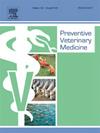西班牙圈养的非人灵长类动物的钩端螺旋体血清调查
IF 2.2
2区 农林科学
Q1 VETERINARY SCIENCES
引用次数: 0
摘要
钩端螺旋体病是由钩端螺旋体的血清型引起的一种世界性人畜共患病,可感染多种野生和家养物种,非人灵长类动物(NHP)是最易感染的分类群体之一。本研究旨在确定西班牙圈养的非人灵长类动物的血清流行率以及与接触钩端螺旋体相关的潜在风险因素。2007 年至 2021 年期间,从 16 个动物园和野生动物救护中心(WRCs)的 258 只 NHPs 采集了血清,并使用改良微凝集试验(MAT)检测了钩端螺旋体抗体。在评估的 258 只 NHP 中,73 只(28.3%)检测到了抗钩端螺旋体抗体。61.0%(25/41)的分析物种和 87.5%(14/16)的采样中心都发现了血清阳性。检测到六种不同的钩端螺旋体血清阳性,其中以 L. Grippotyphosa 最为普遍。与其他接受检测的 NHP 家族相比,人科的血清阳性率明显更高(61.8%;P < 0.001)。据作者所知,本研究是欧洲对 NHP 进行的最大规模的钩端螺旋体血清调查,也首次报告了九种 NHP 接触钩端螺旋体的情况,扩大了这种人畜共患病细菌的宿主范围。我们的研究结果表明,在西班牙圈养的 NHP 中,钩端螺旋体的血清阳性率很高而且很普遍,这可能会引起保护和动物健康方面的关注。这项研究表明,有必要将圈养的NHP纳入监测计划,以评估这些物种在圈养中心接触钩端螺旋体的情况。本文章由计算机程序翻译,如有差异,请以英文原文为准。
Serosurvey of Leptospira spp. in captive non-human primates in Spain
Leptospirosis is a worldwide zoonotic disease caused by serovars of Leptospira spp. that can infect a wide range of wild and domestic species, highlighting non-human primates (NHPs) as one of the most susceptible taxonomic groups. The aim of the present study was to determine the seroprevalence and potential risk factors associated with exposure to Leptospira spp. in captive NHPs in Spain. Between 2007 and 2021, sera were collected from 258 NHPs in 16 zoos and wildlife rescue centers (WRCs), and tested for antibodies to Leptospira spp. using the modified microagglutination test (MAT). Anti-Leptospira spp. antibodies were detected in 73 (28.3 %) of the 258 NHPs evaluated. Seropositivity was found in 61.0 % (25/41) of the species analyzed and in 87.5 % (14/16) of the sampled centers. Sera seropositive for six different serovars of Leptospira spp. were detected, with L. Grippotyphosa being the most prevalent. Seroprevalence was found to be significantly higher in Hominidae (61.8 %; P < 0.001) compared to other NHP families tested. To the author’s knowledge, the present study is the largest serosurvey of Leptospira spp. conducted in NHPs in Europe and also reports for the first time exposure to Leptospira spp. in nine NHP species, expanding the host range for this zoonotic bacterium. Our results indicate high and widespread seropositivity of Leptospira spp. in NHPs kept in captivity in Spain, which may be of conservation and animal health concern. This study supports the need to include captive NHPs in monitoring programs to evaluate the exposure of these species to Leptospira spp. in captive centers.
求助全文
通过发布文献求助,成功后即可免费获取论文全文。
去求助
来源期刊

Preventive veterinary medicine
农林科学-兽医学
CiteScore
5.60
自引率
7.70%
发文量
184
审稿时长
3 months
期刊介绍:
Preventive Veterinary Medicine is one of the leading international resources for scientific reports on animal health programs and preventive veterinary medicine. The journal follows the guidelines for standardizing and strengthening the reporting of biomedical research which are available from the CONSORT, MOOSE, PRISMA, REFLECT, STARD, and STROBE statements. The journal focuses on:
Epidemiology of health events relevant to domestic and wild animals;
Economic impacts of epidemic and endemic animal and zoonotic diseases;
Latest methods and approaches in veterinary epidemiology;
Disease and infection control or eradication measures;
The "One Health" concept and the relationships between veterinary medicine, human health, animal-production systems, and the environment;
Development of new techniques in surveillance systems and diagnosis;
Evaluation and control of diseases in animal populations.
 求助内容:
求助内容: 应助结果提醒方式:
应助结果提醒方式:


